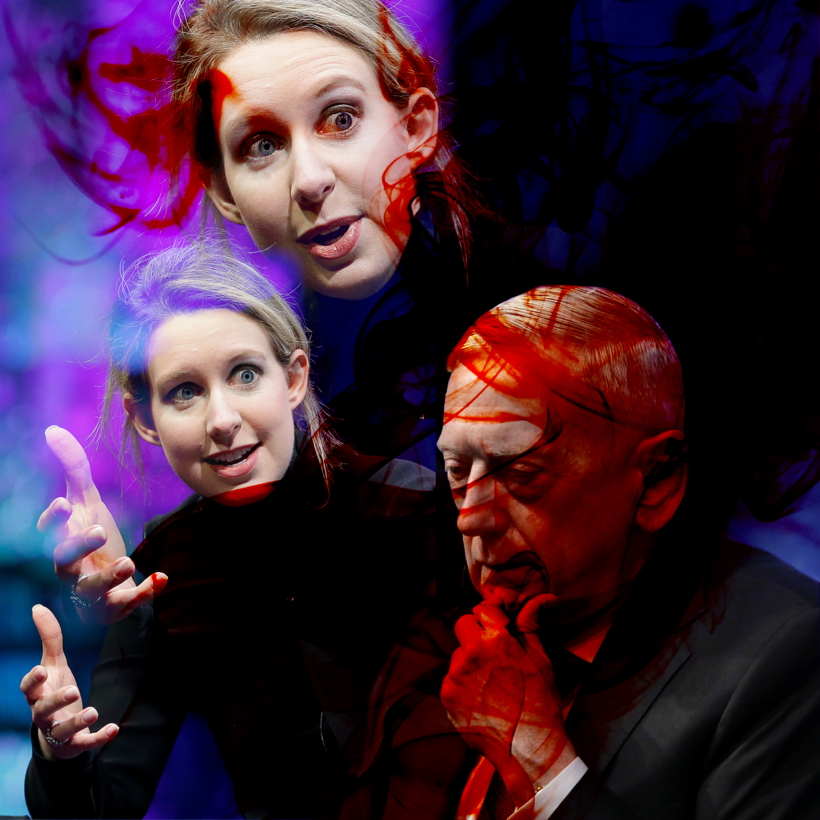She pricked his finger, handled his blood, and lied.
Week three of the Elizabeth Holmes trial featured the prosecution’s first star witness, Jim “Mad Dog” Mattis. A four-star general before serving as Donald Trump’s secretary of defense, Mattis was sold on the Edison machine—the desktop device Holmes claimed could process hundreds of medical tests with a single drop of blood—by Holmes herself. She demonstrated by personally drawing the general’s blood. She wore a white lab coat in such situations, her voice deep, her eyes unblinking, her hair drawn back in a tight Nurse Diesel bun. If Mattis had known the truth, that most of these tests were sent out for processing on traditional machines—in the underworld, they call this a “long con”—it would have “tempered my enthusiasm significantly,” such a setup being “useless to [the army].”
Mattis became a Theranos champion instead, pushing for military use of the machine, then investing $85,000 of his own money—so he would have some “skin in the game.” He later took a seat on the Theranos board, where, according to the general, he got the sense—this coming from a military man, a student of hierarchies—that Holmes was in firm command, a picture that veers sharply from that painted by the defense, who suggest Holmes was being bigfooted and possibly abused by business and love partner Sunny Balwani, who stands trial this winter.

In Mattis’s telling, Holmes controlled everything at Theranos. She even told him what to say to the reporters writing the Theranos puff pieces. The jury was presented with some of those articles in week three. Compare what she told Fortune and The Wall Street Journal to what she knew was actually going on in her lab. The term for that is “lying.” “There came a point,” Mattis told the jury, “when I didn’t know what to believe about Theranos anymore.”

The previous week had ended with Erika Cheung on the stand, and something about her experience at Theranos haunted me as Mattis described the atmosphere around Holmes. Cheung, who worked at the company for less than a year, believed she was being followed after she quit. Lights in the rearview mirror. Shadows on the wall. The sort of thing that makes a person wonder if they’re going nuts. It must have been a relief for Cheung to learn, via a recent release of documents, that Theranos did in fact pay a private investigator $150,000 to tail her and fellow whistleblower—and probable future witness—Tyler Shultz, grandson of George. In company files, this operation was named like a fusion band: “The E. Cheung & T. Shultz project.”
Reading over Mad Dog’s testimony—“I didn’t know what to believe …”—I couldn’t stop thinking about that private dick. It gets at something fundamental about Theranos, the people who ran the company, and the way they did business. It was all cloak and dagger, smoke and mirrors, threats and paranoia. Employees with bad news were ignored, admonished, fired, threatened, tailed. (Theranos was in the wrong trade. They sucked at medical testing but rocked at surveillance.) And it continues even now, first as tragedy, then as farce.
“There came a point,” Mattis told the jury, “when I didn’t know what to believe about Theranos anymore.”
During jury selection, the press corps was approached and befriended by an average-seeming sort, a Joe Schmo who introduced himself as “Hanson.” Hanson, who said he covered his nut fixing antique cars—because, you know, he’s just like you and me—claimed he’d come less to watch the trial than to keep an eye on the press. In reports, he is described as wearing “a baseball cap and a Patagonia puffer jacket.” He is also described as eating “a Rice Krispie Treat pulled fresh from his pocket.”

“No journalist has ever told the real story about [Holmes],” said Hanson. “Everyone is just copy and pasting each other’s stories without thinking.”
Asked if he knew Holmes, Hanson answered cryptically, in the way of a Zen master: “Do I know her? Does anyone know her? What does it even mean to know someone these days?”
A week or so later, reporters noticed Hanson walking Holmes into court, because, as it turned out, Hanson was not a regular Joe, nor a press watchdog, but the defendant’s father-in-law, Bill Evans, “San Diego hotel kingpin” and owner of an antique-car museum. (NPR published a picture of Evans at the wheel of a 1905 Pope-Toledo Type IV Roi des Belges Tonneau in Pebble Beach in 2015.)
The fact that he did not really go by “Hanson” was first noted by a reporter who spotted the name on the man in the puffer jacket’s Starbucks cup: Billy. Or maybe Bill. And the loafers! Salvatore Ferragamos! Five hundred bucks at least—that alone should have been a giveaway. Evans, who had apparently been trying to glean info from the media, smiled sweetly when asked why he’d called himself “Hanson.” Why? Because “people have nicknames.”

All of which demonstrates a fundamental flaw in the legal system, which, broadly defined, includes private dicks as well as police, lawyers, judges, and F.B.I. agents. It’s often not a question of who is right and who is wrong but of who is willing to go furthest and spend most. Though every citizen is technically entitled to a day in court, it can cost so much to navigate the maze to the judge that many, fearing the process will be financially or reputationally ruinous, keep quiet. Thus, the legal strategy: you can blow the whistle, but it’s going to cost you everything. It’s what Kafka meant when he said the trial becomes the punishment.
Theranos made the prospect of sounding the alarm seem so onerous that it was years before a few conscience-stricken ex-employees, either rich or young or stupid enough to testify, turned up. As with Madoff, the mystery is not how the enterprise collapsed but why it took so long. In both cases, the same answer can apply: because there were too many important people benefiting from the fairy tale, from the illusion of success.
As with Madoff, the mystery is not how the enterprise collapsed but why it took so long.
And now the script has been flipped. Holmes, who used the size of her kitty and the vintage of her representation to bully employees, has been put on trial by lawyers who have even more resources than she does: the United States Attorney for the Northern District of California.
Week three began with Surekha Gangakhedkar, a Theranos scientist, who said she personally told Holmes that the results given by the Edison were not trustworthy, which is why Gangakhedkar was shocked into resigning by the news that Theranos would put the machines into Walgreens stores anyway.
Then came Brittany Gould, a civilian who had given blood for a test in one of those Walgreens in 2014. Gould was pregnant. The Edison wrongly suggested she was “suffering a miscarriage.” Gould told the jury about the surprise and sadness she felt, how she dreaded telling her seven-year-old daughter there would be no baby after all. (She did have the baby.)
Then came Mattis.

At the end of the week, prosecutors read texts to the jury that Holmes and Bulwani had sent back and forth like a shuttlecock, some of which demonstrate that Holmes knew exactly what was happening at Theranos and some of which show her going as mad as Colonel Kurtz (“My new life as of this night and forever more:—total confidence in myself best business person of the year”), some of which show Bulwani deluding himself (“They are not investing in our company they are investing in our destiny”) and some of which demonstrate why you never want the world to read your late-night missives:
Holmes:
You are the breeze in desert for me.
My water.
And ocean.
Meant to be only together tiger.
Balwani:
OK.
Theranos was based on a simple idea expressed by a charismatic founder. In this way, it was less a traditional business than it was a myth, a collective dream. She’s going to change the world, and we’re going to get rich in the process. That’s a win-win. But it was magical thinking, driven by a machine that never came close to working, not because Holmes ran out of money or time, nor because she was set upon by a reporter from The Wall Street Journal, but because it could not work, as the technology that would have made it work does not exist. She was selling a cake but had only icing.
Fascinating as all this may be, the most telling moment in this saga came not this week or last month but years ago, when Elizabeth Holmes was in grade school, with a story she often told about herself then, a fable meant to express her ingenuity, intelligence, and drive.
“I was probably, definitely, not normal,” Holmes told The New Yorker in 2014. “I was reading ‘Moby-Dick’ from start to finish when I was about nine. I read a ton of books. I still have a notebook with a complete design for a time machine that I designed when I must have been, like, seven.”
This story is great, because it says more than Holmes intends. The time machine is the Edison prefigured, a design for a device that can be made only in fantasyland.
“The wonderful thing about the way I was raised is that no one ever told me that I couldn’t do those things,” she told The New Yorker.
Never did, but maybe should have.
Rich Cohen is a Writer at Large for Air Mail


